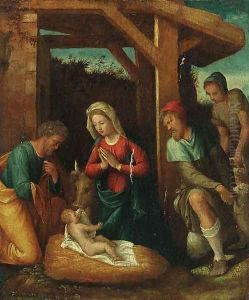Benvenuto De Garofalo Paintings
Benvenuto Tisi (or Il Garofalo), born in 1481 in Ferrara, Italy, was an Italian painter of the Renaissance period. He is often referred to as Benvenuto De Garofalo, which is derived from his attachment to the Garofalo family, who were his patrons, and the presence of a clove of garlic (garofalo in Italian) in many of his signature marks. His works are characteristic of the Ferrarese school, which was influenced by both the Bolognese and the Roman artistic environments.
Garofalo was initially a pupil of Domenico Panetti and later Lorenzo Costa the elder, where he was exposed to the Bolognese style of painting. He then moved to Rome in his early twenties, which had a profound impact on his artistic development. In Rome, he worked under the guidance of Raphael and became familiar with the work of Michelangelo. The influence of both masters is evident in Garofalo's later works, particularly in his use of color and composition.
After his time in Rome, Garofalo returned to Ferrara where he became one of the leading painters. He worked for the Duke of Ferrara, Alfonso I d'Este, and was involved with many important commissions throughout the city and its surrounding areas. His paintings often featured religious subjects and included altarpieces, frescoes, and smaller devotional works. Garofalo's style combined the grandeur of Roman art with the decorative beauty of the Ferrarese tradition.
Despite his successful career, little is known about Garofalo's personal life. His works were widely appreciated during his lifetime, and he was considered one of the main exponents of the High Renaissance in Northern Italy. Garofalo continued to paint until his eyesight began to fail in 1550, and he is believed to have died in Ferrara in 1559. His legacy includes a number of works that can be seen in major museums around the world, and he remains a significant figure in the study of the Italian Renaissance.
